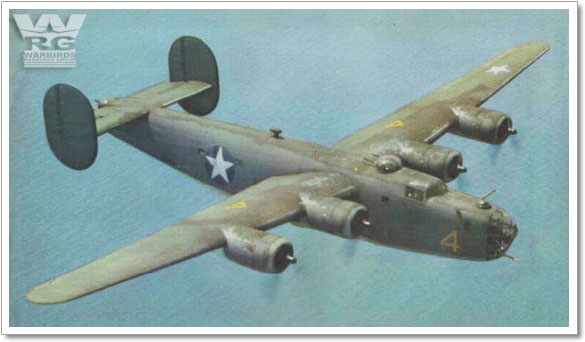U.S.A.A.F. RESOURCE CENTER > BOMBERS > LIBERATOR > PREVIOUS PAGE

[Source: USAF Photo]
At its inception, the B-24 was a modern design featuring a highly efficient shoulder-mounted, high aspect ratio Davis wing. The wing gave the Liberator a high cruise speed, long range and the ability to carry a heavy bomb load. Early RAF Liberators were the first aircraft to cross the Atlantic Ocean as a matter of routine. However, the type was difficult to fly and had poor low speed performance. It also had a lower ceiling and was less robust than the Boeing B-17 Flying Fortress. While aircrews tended to prefer the B-17, General Staff favored the B-24, and procured it for a wide variety of roles.
The B-24 was used extensively in World War II. It served in every branch of the American armed forces, as well as several Allied air forces and navies, and saw use in every theater of operations. Along with the B-17, the B-24 was the mainstay of the US strategic bombing campaign in the Western European theater. Due to its range, it proved useful in bombing operations in the Pacific, including the bombing of Japan. Long range anti-submarine Liberators played an instrumental role in closing the Mid-Atlantic Gap in the Battle of the Atlantic. The C-87 transport derivative served as a longer range, higher capacity counterpart to the Douglas C-47 Skytrain.
The B-24 was produced in very large numbers. At nearly 19,000 units, with over 8,000 manufactured by Ford Motor Company, it holds the distinction of being the most produced heavy bomber in history, the most produced multi-engine aircraft in history and the most-produced American military aircraft.
At the end of World War II, the Liberator had been surpassed by more modern types such as the Boeing B-29 Superfortress. The type was rapidly phased out of US service, although the PB4Y-2 Privateer derivative carried on in service with the US Navy in the Korean War.
|
– Design/Construction – Operational History – Other Operators – Specifications – Survivors |
– Variants - USAAF – Variants - USN – Variants - British – Image Gallery |
Sources:
Gunston, Bill - The Encyclodepia of the Worlds Combat aircraft, 1976, Chartwell Books, Inc., New York
U.S.A.A.F. RESOURCE CENTER > BOMBERS > LIBERATOR > PREVIOUS PAGE
